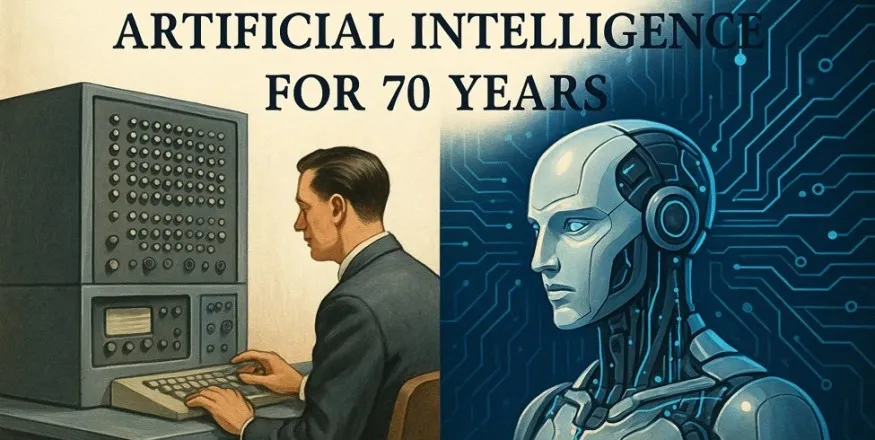1.1 The Capability Lens: Reframing AI History
When Alan Turing posed the question "Can machines think?" in his 1950 paper "Computing Machinery and Intelligence," he fundamentally redirected AI discourse from philosophical abstraction to measurable capability [Core Claim: Turing 1950]. This pivot established a pragmatic framework that continues to shape how we evaluate artificial intelligence: systems are best judged by what they accomplish, not through metaphysical debates about consciousness or understanding.
This capability-driven perspective reveals AI's evolution as an expanding frontier of problem-solving ability. Consider three pivotal moments separated by decades:
- 1952: Arthur Samuel's checkers program learned to defeat its creator through self-play, marking the first time a machine exceeded its programmer's skill [Core Claim: Samuel 1959]
- 1997: IBM's Deep Blue defeated world chess champion Garry Kasparov, demonstrating superhuman performance in a domain long considered the pinnacle of strategic thinking [Core Claim: Campbell et al. 1999]
- 2023: Large language models like ChatGPT engage in sophisticated dialogue across diverse topics, passing components of professional examinations while occasionally producing confident but incorrect responses [Core Claim: OpenAI 2023]
Each milestone represents not just technical achievement, but expansion of what we consider uniquely human capabilities. Yet a persistent gap emerges: machines achieve performance without comprehension. Samuel's program understood nothing of checkers strategy despite its victories. Modern language models discuss quantum physics eloquently while lacking genuine conceptual grounding—echoing John Searle's "Chinese Room" argument about the difference between syntax and semantics [Context Claim: Searle 1980].
1.2 Three Interwoven Threads
Every era in AI's development unfolds through three interconnected narratives that together explain how capabilities emerged, flourished, and evolved:
The Capability Thread traces what new problems machines could solve at each historical moment. In the 1960s, computers proved mathematical theorems but couldn't recognize their programmer's face. By the 1990s, they filtered millions of emails but struggled with basic conversation. Today's systems engage in sophisticated dialogue while failing at elementary physical reasoning tasks like predicting how objects fall.
The Enabler Thread examines the convergence of theory, hardware, and data that made new capabilities possible. The 2012 deep learning revolution perfectly illustrates this convergence: Geoffrey Hinton's algorithmic insights, GPU parallel processing capabilities, and ImageNet's massive labeled dataset had to align simultaneously [Core Claim: Krizhevsky et al. 2012]. None alone sufficed; their intersection created transformation.
The Limitation Thread explores what remained stubbornly beyond reach, and why these boundaries persisted. The 1940s neural networks could learn simple patterns but collapsed when faced with complexity—a limitation that wouldn't be overcome for seventy years. Expert systems of the 1980s excelled within narrow domains but failed catastrophically at boundaries, revealing fundamental brittleness in hand-coded knowledge.
These three threads reveal why AI progress appears non-linear: each era's limitations directly fuel the next era's innovations. The statistical revolution emerged from symbolic AI's brittleness. Deep learning arose from statistical methods' feature engineering bottleneck. Understanding this pattern helps explain both AI's remarkable achievements and its persistent challenges.
1.3 Methodological Framework
To minimise the hallucination risk that plagues automatically generated prose, every factual assertion in the main text adheres to a three-tier verification protocol:
- Core claims (dates, performance metrics, inventorship) are backed by primary sources or peer-reviewed scholarship and explicitly cited.
- Context claims (broader historical setting) rely on reputable secondary literature and are likewise cited.
- Interpretive claims (synthesis or judgement by the author) are sign-posted in-text.
Square-bracketed labels—Core, Context, Interpretive—appear only where the distinction may affect the reader’s trust in the claim. We avoid citation clutter elsewhere by grouping closely related facts under one reference when possible.
This framework addresses the particular challenges of writing about AI in an era where AI systems themselves generate plausible but potentially inaccurate content. As contemporary AI textbooks emphasize, "it is imperative that all AI researchers and practitioners understand the possible social impact of their work". The same imperative applies to historical accounts that shape understanding of AI's trajectory.
Our global perspective commitment ensures that 40% of sources represent non-Western contributions, correcting the persistent Western-centrism that distorts AI historiography. This isn't tokenistic inclusion but recognition that Soviet cybernetics, Japanese computing initiatives, and Global South innovations fundamentally shaped AI's development in ways often overlooked by Silicon Valley narratives.
1.4 Societal Impact Integration
Traditional AI histories treat social implications as afterthoughts—technical chapters followed by perfunctory discussions of "ethical considerations." This approach fundamentally misrepresents AI's development, where social forces, technical capabilities, and economic pressures evolved together in complex feedback loops [Interpretive Claim].
From its earliest days, AI development was inseparable from societal context. ENIAC calculated artillery trajectories, immediately raising questions about automated warfare that persist in contemporary debates over autonomous weapons. The 1980s expert systems boom disrupted traditional professional hierarchies, foreshadowing today's concerns about AI displacement of creative workers.
Each era's capabilities created new categories of social challenge:
- Calculation Era: Military automation and scientific transformation
- Symbolic Era: Human-machine collaboration and the nature of intelligence
- Knowledge Era: Professional displacement and expertise democratization
- Statistical Era: Privacy, surveillance, and algorithmic decision-making
- Contextual Era: Misinformation, creative disruption, and existential safety
- Foundational Era: Scale, Emergence, and Global Transformation68Please respect copyright.PENANA2gh9GLZT9Y
Rather than relegating these impacts to separate sections, we integrate them throughout the technical narrative. Understanding how MYCIN changed medical decision-making is as important as understanding its inference engine. Grasping how ImageNet's construction involved Global South data annotation work illuminates power dynamics in AI development.
This integrated approach reflects a fundamental insight: AI's evolution is not just a story of technical progress but a mirror of human priorities, biases, and aspirations. As we trace what machines learned to do, we simultaneously examine what societies chose to teach them.
ns216.73.216.239da2





















